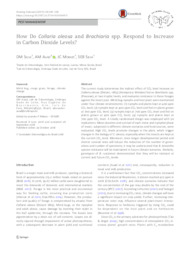How do Collaria oleosa and Brachiaria spp. respond to increase in carbon dioxide levels?
How do Collaria oleosa and Brachiaria spp. respond to increase in carbon dioxide levels?
Autoria: AUAD, A. M.
Resumo: The current study determines the indirect effect of CO2 level increase on Collaria oleosa (Distant, 1863) (Hemiptera: Miridae) fed on Brachiaria spp. (Poaceae), at two trophic levels, and evaluates resistance to these forages against the insect pest. Mirid bug nymphs and host plant were maintained under four climate environments: (1) nymphs and plants kept at 400 ppm CO2 level; (2) nymphs kept at 400 ppm CO2 level and fed on plants grown at 700 ppm CO2 level; (3) nymphs kept at 700 ppm CO2 level and fed on plants grown at 400 ppm CO2 level; (4) nymphs and plants kept at 700 ppm CO2 level. A totally randomized design was employed with 50 replications. Mean duration and survival of each instar and nymphal phase of insect, subjected to different climate scenarios and food sources, were evaluated. High CO2 levels promote changes in the plant, which trigger changes in the biology of C. oleosa, especially when the insects are kept at the current CO2 level. Moreover, since longer developmental period and shorter survival rates will induce the reduction of the number of generations and number of specimens, it may be underscored that B. brizantha species resistance will be maintained in future climate scenarios. Similarly, genotypes of B. ruziziensis demonstrated that they will be resistant at current and future CO2 levels.
Ano de publicação: 2019
Tipo de publicação: Artigo de periódico
Unidade: Embrapa Gado de Leite
Palavras-chave: Climate change, Congo grass, Forage, Mirid bug
Observações
1 - Por padrão são exibidas publicações dos últimos 20 anos. Para encontrar publicações mais antigas, configure o filtro ano de publicação, colocando o ano a partir do qual você deseja encontrar publicações. O filtro está na coluna da esquerda na busca acima.
2 - Para ler algumas publicações da Embrapa (apenas as que estão em formato ePub), é necessário ter, no celular ou computador, um desses softwares gratuitos. Sistemas Android: Google Play Livros; IOS: iBooks; Windows e Linux: software Calibre.
Acesse outras publicações
Acesse a Base de Dados da Pesquisa Agropecuária (BDPA) para consultar o acervo completo das bibliotecas da Embrapa.

